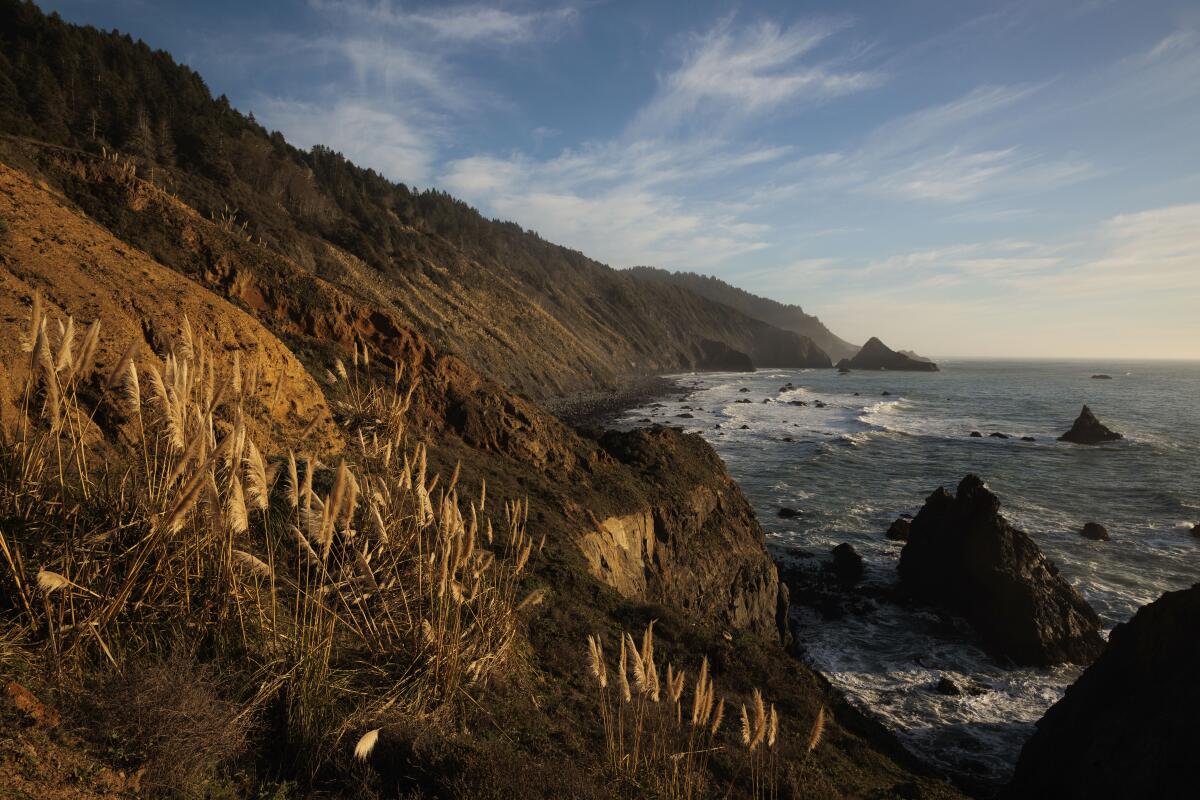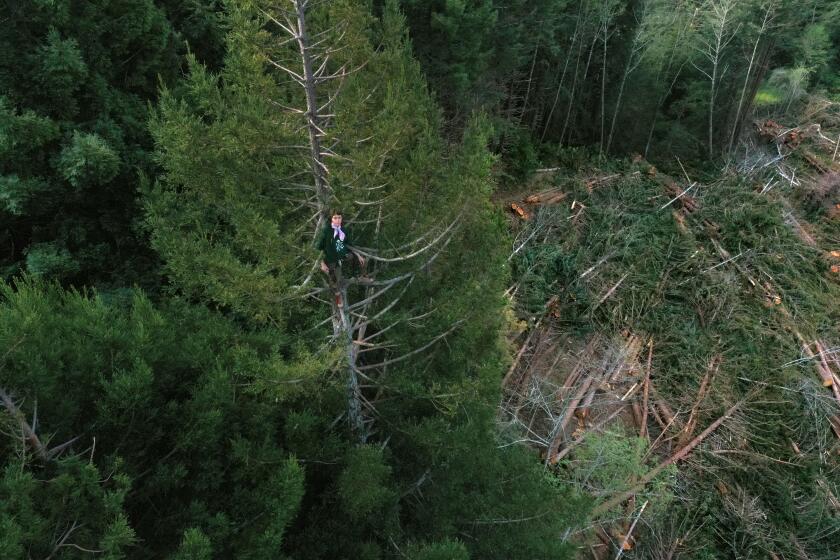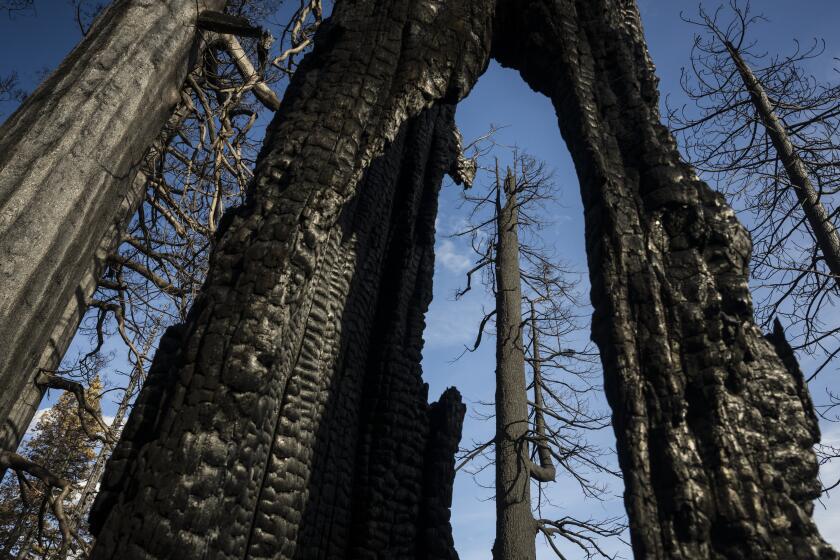Conservation group bids to save redwoods on Northern California’s Lost Coast

The rugged Lost Coast is about to become less forbidding.
A conservation group on Thursday said it planned to purchase a scenic five-mile stretch of the Northern California coastline from a lumber company to protect it from logging and eventually open it up to the public.
The Save the Redwoods League said it agreed to pay nearly $37 million for the DeVilbiss Ranch if it can raise the money by the end of the year.
“This is a piece of California that inspires,” said Sam Hodder, the league’s president and chief executive. “It’s a once-in-a-lifetime opportunity.”
The property sits at the southern end of the largely undeveloped Lost Coast, an unruly landscape untamed by highways and surrounded by timberlands off-limits to the public.
Forested hills on the ranch plunge to isolated beaches. Waves crash into sea stacks. Lush forests teem with green ferns and thick moss. Redwoods and firs up to a century old tower overhead. Two creeks harbor coho salmon and steelhead trout. Grasslands and woods are home to Roosevelt elk, deer and mountain lions. Habitat supports endangered species such as the northern spotted owl, marbled murrelet and Pacific fisher.
Some old-growth redwoods remain on the ridgeline where strong winds snarled their tops, making them less valuable as lumber and sparing them the saw blade.
The property near Rockport, 155 miles north of San Francisco, is the largest privately owned section of California coastline in the redwood range that runs from Oregon to Big Sur, Hodder said.
In Humboldt County, a tradition endures even amid the coronavirus crisis. Logging companies continue to fell trees, as protesters try to stop them.
It’s being sold by Soper Co., parent of Soper-Wheeler, which is leaving logging after 160 years of family ties to the business.
“You’d be hard pressed to find five miles of coastline for sale without going to a Third World country,” said Aric Starck, executive chairman of Soper and a member of the family that owns it. “This one is very unique.”
Logging companies, ranches and other conservation groups also bid on the property, Starck said.
The five-square-mile property was selectively logged so it doesn’t feature the gaping clear-cuts found in some timberlands, Hodder said. Much of the forest is second-growth redwoods that are 80 to 100 years old and top 200 feet in height.
Soper is selling its lands because it’s gotten harder to make a profit in a timber industry that has consolidated and faces tougher environmental restrictions, Starck said. Like other multi-generational family businesses, it has run into the problem of having a growing number of heirs with interests outside logging.
The company has sold all but one-fifth of the 172 square miles of land it began selling three years ago. It plans to sell all of its acreage by the end of next year.
“It’s a sad point in the company’s history,” Starck said. “These are truly unique properties and it’s always hard to part with them.”
The area was aggressively logged since the late 1800s and most of the area was cleared by the turn of the last century, Hodder said. Only 5% of all old-growth coast redwoods, the tallest trees on the planet, remain today.
‘There is nothing alive on that tree’: Inside a giant sequoia grove scorched by the KNP Complex fire
Most of the giant sequoias killed by the KNP Complex fire were in a single grove, where flames may have blanketed the tops of the trees that rise more than 250 feet.
Logging and other private lands kept much of the Lost Coast area off-limits until the 1970s when the King Range National Conservation Area was created.
The Lost Coast Trail, an arduous hiking route along desolate rocky beaches that vanish at high tide, through river crossings and across steep bluffs, follows the shore.
The trail could be extended five miles with the acquisition, Hodder said. The league will survey the land for possible routes and public access.
Richard Gienger, a watershed advocate in the area, welcomed news of the purchase but said much of the rugged shoreline will remain inaccessible. The property ends just short of another timber company’s land where Cottaneva Creek spills into the Pacific, which would provide easy access to a beach.
“This is very significant access, but I don’t think it can be overly stressed: The link to having public access to the beach at Rockport is the next step and will probably cost twice as much,” Gienger said.
Save the Redwoods owns a property just south of that beach and also owns the Shady Dell area directly north of the ranch that connects to the Sinkyone Wilderness State Park.
The league plans to eventually turn over its properties to a public or tribal agency to manage. It’s protected over 200,000 acres of forest that have become parts of 66 state and national parks and preserves.
It typically transfers the property at some percentage of fair market value.
“That allows the public agency to get it at a significant bargain,” Gienger said. “The risk the league takes stepping in and buying property is the risk public agency collaborators can’t take.”
Michael Evenson, vice president of the Lost Coast League, which advocates for protecting water and wildlife in the area, said the purchase would further help link areas where diverse species can migrate to cooler areas as the climate heats up.
“If there are only islands of timber company land, which are younger and hotter and more prone to fire, they don’t create these wildlife corridors,” Evenson said. “This kind of purchase could have very good consequences for a lot of species that will seek out this terrain that humans can’t get to very easily.”
So far, $10 million has been committed toward the purchase, but the league is also trying to raise an additional $6.5 million needed to manage and protect the property. The total $43.4 million it is raising is the most it has sought in such a short time period.
It is launching a digital fundraising effort Friday and will consider applying for low-interest financing or using reserves if it falls short of its goal.
More to Read
Sign up for Essential California
The most important California stories and recommendations in your inbox every morning.
You may occasionally receive promotional content from the Los Angeles Times.












